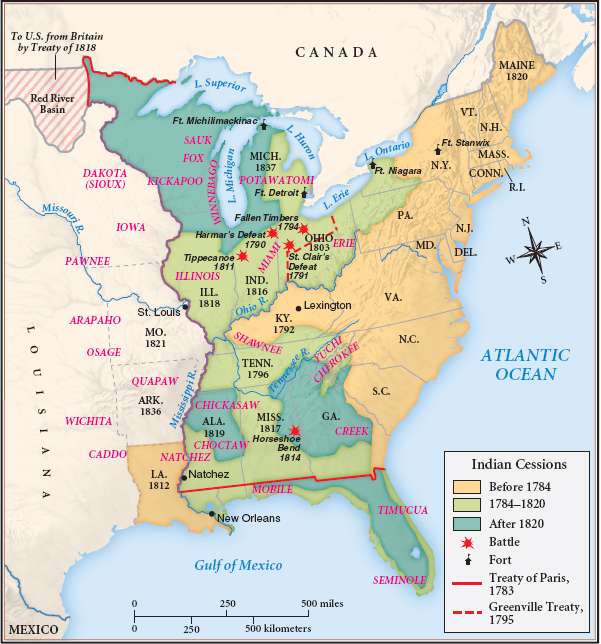Sham Treaties and Indian Lands
As in the past, the major struggle between natives and Europeans centered on land rights. Invoking the Paris treaty and regarding Britain’s Indian allies as conquered peoples, the U.S. government asserted both sovereignty over and ownership of the trans-Appalachian west. Indian nations rejected both claims, pointing out they had not been conquered and had not signed the Paris treaty. “Our lands are our life and our breath,” declared Creek chief Hallowing King; “if we part with them, we part with our blood.” Brushing aside such objections and threatening military action, U.S. commissioners forced the pro-British Iroquois peoples — Mohawks, Onondagas, Cayugas, and Senecas — to cede huge tracts in New York and Pennsylvania in the Treaty of Fort Stanwix (1784). New York land speculators used liquor and bribes to take a million more acres, confining the once powerful Iroquois to reservations — essentially colonies of subordinate peoples.
American negotiators used similar tactics to grab Ohio Valley lands. At the Treaties of Fort McIntosh (1785) and Fort Finney (1786), they pushed the Chippewas, Delawares, Ottawas, Wyandots, and Shawnees to cede most of the future state of Ohio. The tribes quickly repudiated the agreements, justifiably claiming they were made under duress. Recognizing the failure of these agreements, American negotiators arranged for a comprehensive agreement at Fort Harmar (1789), but it, too, failed. To defend their lands, these tribes joined with the Miami and Potawatomi Indians to form the Western Confederacy. Led by Miami chief Little Turtle, confederacy warriors crushed American expeditionary forces sent by President Washington in 1790 and 1791.

The Treaty of Greenville Fearing an alliance between the Western Confederacy and the British in Canada, Washington doubled the size of the U.S. Army and ordered General “Mad Anthony” Wayne to lead a new expedition. In August 1794, Wayne defeated the confederacy in the Battle of Fallen Timbers (near present-day Toledo, Ohio). However, continuing Indian resistance forced a compromise. In the Treaty of Greenville (1795), American negotiators acknowledged Indian ownership of the land, and, in return for various payments, the Western Confederacy ceded most of Ohio (Map 7.2). The Indian peoples also agreed to accept American sovereignty, placing themselves “under the protection of the United States, and no other Power whatever.” These American advances caused Britain to agree, in Jay’s Treaty (1795), to reduce its trade and military aid to Indians in the trans-Appalachian region.
The Greenville treaty sparked a wave of white migration. Kentucky already had a population of 73,000 in 1790, and in 1792 it was admitted to the Union as the fifteenth state (Vermont entered a year earlier). By 1800, more than 375,000 people had moved into the Ohio and Tennessee valleys; in 1805, the new state of Ohio alone had more than 100,000 residents. Thousands more farm families moved into the future states of Indiana and Illinois, sparking new conflicts with native peoples over land and hunting rights. Between 1790 and 1810, farm families settled as much land as they had during the entire colonial period. The United States “is a country in flux,” a visiting French aristocrat observed in 1799, and “that which is true today as regards its population, its establishments, its prices, its commerce will not be true six months from now.”
Assimilation Rejected To dempen further conflicts, the U.S. government encouraged Native Americans to assimilate into white society. The goal, as one Kentucky Protestant minister put it, was to make the Indian “a farmer, a citizen of the United States, and a Christian.” Most Indians rejected wholesale assimilation; even those who joined Christian churches retained many ancestral values and religious beliefs. To think of themselves as individuals or members of a nuclear family, as white Americans were demanding, meant repudiating the clan, the very essence of Indian life. To preserve “the old Indian way,” many native communities expelled white missionaries and forced Christianized Indians to participate in tribal rites. As a Munsee prophet declared, “There are two ways to God, one for the whites and one for the Indians.”
A few Indian leaders sought a middle path in which new beliefs overlapped with old practices. Among the Senecas, the prophet Handsome Lake encouraged traditional animistic rituals that gave thanks to the sun, the earth, water, plants, and animals. But he included Christian elements in his teachings — the concepts of heaven and hell and an emphasis on personal morality — to deter his followers from alcohol, gambling, and witchcraft. Handsome Lake’s teachings divided the Senecas into hostile factions. Led by Chief Red Jacket, traditionalists condemned European culture as evil and demanded a complete return to ancestral ways.
Most Indians also rejected the efforts of American missionaries to turn warriors into farmers and women into domestic helpmates. Among eastern woodland peoples, women grew corn, beans, and squash — the mainstays of the Indians’ diet — and land cultivation rights passed through the female line. Consequently, women exercised considerable political influence, which they were eager to retain. Nor were Indian men interested in becoming farmers. When war raiding and hunting were no longer possible, many turned to grazing cattle and sheep.

PLACE EVENTS IN CONTEXT